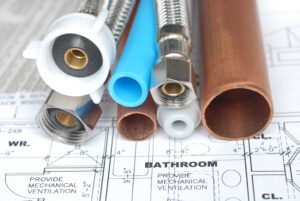Blueprints are essential documents in the construction industry, providing detailed instructions for building structures. However, deciphering the symbols and annotations can be daunting to the untrained eye. These blueprints contain a secret language of symbols in plumbing that convey crucial information about pipe layouts, fixture placements, and drainage systems. Let’s explore some common plumbing symbols found in blueprints and decode the mysteries they hold:
Pipe Symbols
Pipes are the lifelines of plumbing systems, transporting water, gas, and waste throughout a building. On blueprints, pipes are represented by various symbols that indicate their material, size, and purpose. For example, a solid line represents a main water supply pipe, while a dashed line denotes a drain or waste pipe. Different colors may also distinguish between different pipe materials, such as blue for cold and red for hot water lines.
Fixture Symbols
Plumbing fixtures, such as sinks, toilets, and showers, are depicted using specific symbols on blueprints. These symbols provide precise information about the type and location of each fixture within a building. For instance, a circle with a cross inside typically represents a toilet, while a rectangle with two small circles above it signifies a sink. Understanding these symbols is essential for accurately installing fixtures according to the blueprint specifications.
Valve Symbols
Valves control water flow and other fluids within a plumbing system. On blueprints, valve symbols indicate the location and type of each valve, whether it’s a gate valve, ball valve, or globe valve. These symbols help plumbers identify key points where valves need to be installed and ensure proper functionality of the plumbing system.
Vent Symbols
Plumbing vents are essential for maintaining proper air pressure and preventing sewer gases from entering a building. Vent symbols on blueprints typically resemble upside-down triangles or T-shaped lines, indicating the location of vent pipes throughout the plumbing system. Proper venting is critical for ensuring drainage systems’ efficient and safe operation.
Drainage Symbols
Drainage symbols on blueprints represent wastewater paths flowing out of fixtures and exiting the building. Arrows indicate the direction of flow, while symbols such as circles and squares represent drain connections and cleanouts. By following these symbols, plumbers can install drainage systems that effectively remove wastewater and prevent backups or blockages.
Legend and Key
Blueprints often include a legend or key explaining the various symbols used throughout the document. This key serves as a reference guide for interpreting the blueprint and understanding the meaning behind each symbol. By consulting the legend, plumbers can ensure that they interpret the blueprint accurately and execute the plumbing installation according to specifications.
In conclusion, understanding the secret language of plumbing symbols is essential for accurately interpreting blueprints and executing plumbing installations precisely. By decoding the mysteries of these symbols, plumbers can ensure that plumbing systems are installed correctly and function efficiently within residential and commercial buildings.
Ready to decode the mysteries of plumbing blueprints? Contact Top Tier Plumbing and Rooter today at (951) 475-6521 for expert plumbing services tailored to your construction project’s needs or home plumbing maintenance services.


